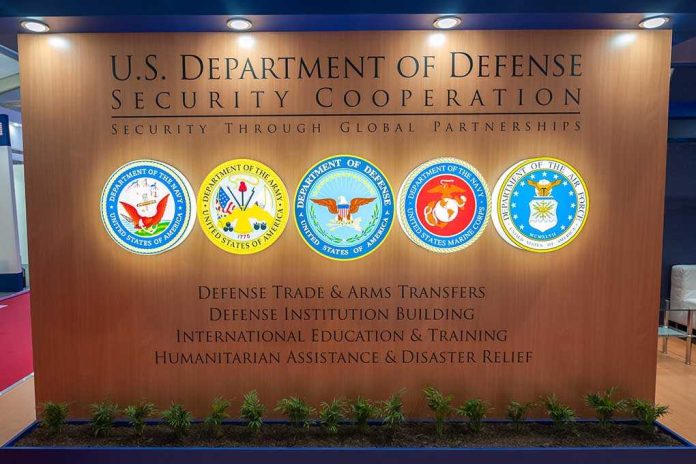
Over 350 unauthorized drone incursions at U.S. military bases have sparked urgent demands from Republican lawmakers for immediate overhaul of outdated counter-drone protocols that leave America’s defense infrastructure dangerously vulnerable.
Key Takeaways
- House Republicans, led by Rep. William Timmons (R-SC), are demanding answers from federal agencies after military bases reported over 350 drone incursions at more than 100 facilities in 2024.
- Current regulations require base commanders to confirm “hostile intent” before taking action against drones—a bureaucratic hurdle lawmakers consider dangerously outdated given the speed of modern drone threats.
- The Military and Foreign Affairs Subcommittee has sent letters to the Departments of Defense, Transportation, and Justice demanding documents on interagency policies and incident reports by July 10, 2025.
- Lawmakers are pushing for expanded authority for military installations and critical infrastructure to deploy advanced counter-drone technologies, including electronic warfare and laser defense systems.
- Russia’s use of Iranian-made kamikaze drones in Ukraine demonstrates the evolving threat that unauthorized drones pose to military and civilian targets.
Military Bases Face Unprecedented Drone Threat
U.S. military installations across the nation are experiencing an alarming surge in unauthorized drone activity, with over 350 incursions reported at more than 100 bases in 2024 alone. This dramatic increase has prompted House Republicans to demand immediate answers and action from federal agencies responsible for protecting America’s critical defense infrastructure. The situation reached a critical point in December 2023, when drones were observed flying over Langley Air Force Base in Virginia for over two weeks without effective countermeasures being deployed.
“Recent high-profile incursions near sensitive military facilities, power infrastructure, and public events suggest that the current framework for domestic counter-drone operations remains fragmented and, in some cases, insufficiently agile to meet evolving threats,” stated lawmakers in their formal inquiry to federal agencies, according to Townhall.
Outdated Protocols Hamper Effective Response
Current regulations governing military responses to drone incursions are woefully inadequate for addressing modern threats. Base commanders must confirm “hostile intent” before taking action against unauthorized drones—a requirement that lawmakers consider dangerously outdated given the speed and potential lethality of modern drone technology. This bureaucratic hurdle significantly delays response times and creates vulnerabilities that could be exploited by adversaries. The fragmented nature of counter-drone authorities across federal agencies further complicates effective response, with only a few departments legally authorized to interfere with drone operations.
“This is a rapidly evolving threat that requires a unified and proactive response,” stated the letter from the House Republicans, according to DroneXL.
Lessons from Global Drone Warfare
The urgency behind these demands stems partly from observing how drone warfare has transformed global conflicts. Russia’s invasion of Ukraine has demonstrated the devastating potential of low-cost, GPS-guided “kamikaze drones” like the Iranian-made Shahed-136. These readily available technologies have transformed drones from mere surveillance tools into lethal weapons capable of precision strikes against high-value targets. The integration of artificial intelligence with drone technology is further magnifying these threats, creating smarter, more autonomous systems that can potentially evade traditional countermeasures.
“The Preventing Emerging Threats Act of 2018 grants the Department of Homeland Security statutory authority to counter credible threats from unmanned aircraft systems (UAS) to the safety or security of a covered facility or asset,” states a Department of Homeland Security document, highlighting existing but limited federal authority to address drone threats.
Lawmakers Demand Comprehensive Reform
The Subcommittee on Military and Foreign Affairs has formally requested documents on interagency policies, incident reports dating back to January 2022, and plans for establishing a joint task force by July 10, 2025. These demands reflect growing frustration with what lawmakers describe as an “improvised and bureaucratically delayed” approach to counter-drone operations. Republicans are advocating for legislative reform that would streamline authority and enhance data sharing between agencies, potentially including expanded protections under Title 10 Section 130(i) and clarification of FAA regulations restricting drone flights over sensitive sites.
“To better understand this issue, the Subcommittee is requesting documents and information concerning the federal government’s authorities and operational posture for countering unmanned aerial systems (cUAS) within the United States, with particular attention to discrepancies in how threats from unmanned versus manned aircraft are treated under current law and policy,” stated lawmakers in their formal inquiry, according to Townhall.
Technology Gap Leaves Bases Vulnerable
A critical aspect of the lawmakers’ concerns focuses on the uneven deployment of advanced counter-UAS systems across U.S. military installations. Electronic warfare capabilities, radar detection systems, and laser defense technologies exist but are not universally available at all bases, creating a patchwork of protection with significant gaps. Detection systems utilizing radiofrequency monitoring, radar, electro-optical sensors, infrared technology, and acoustic capabilities are essential for early warning, but their implementation may conflict with federal surveillance laws, further complicating deployment.
“Capabilities for detecting and mitigating UAS may implicate federal criminal laws relating to surveillance, accessing or damaging computers, and damage to an aircraft,” warns an advisory guidance document cited by DroneLife, highlighting the legal complexity surrounding counter-drone measures.
The push for robust counter-drone protocols represents a critical national security imperative as America faces increasingly sophisticated aerial threats. President Trump’s administration is now confronted with the challenge of securing America’s skies against these evolving threats while balancing legitimate commercial and recreational drone use. The coming months will likely see significant policy changes as federal agencies respond to congressional pressure and work to close the dangerous security gaps at our nation’s most sensitive military installations.









